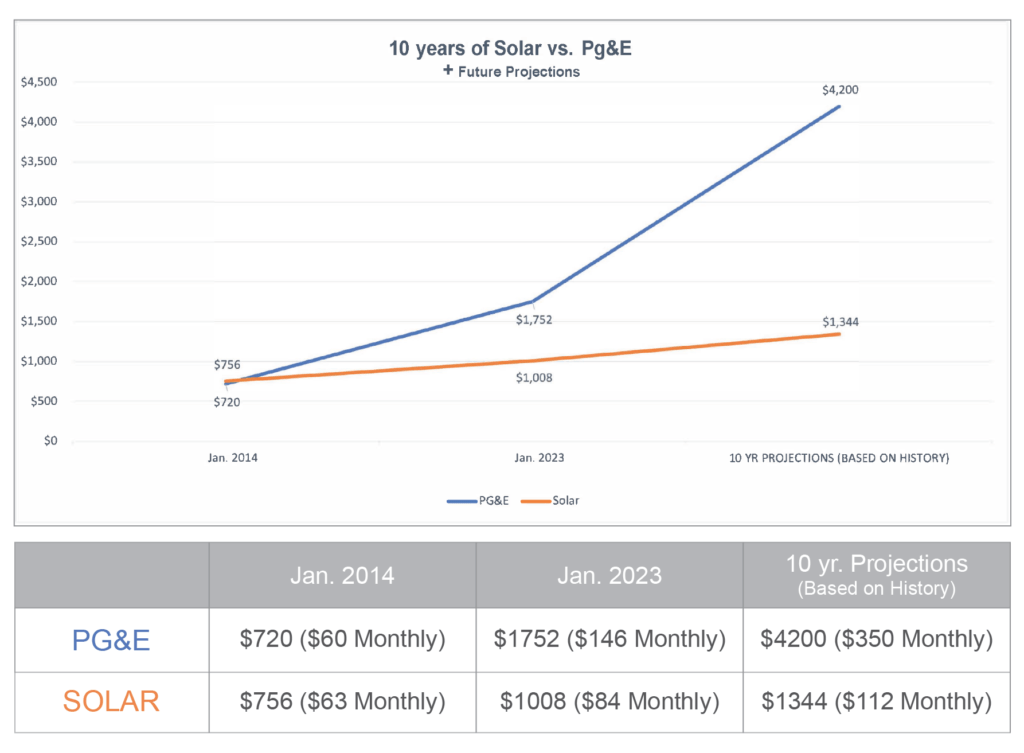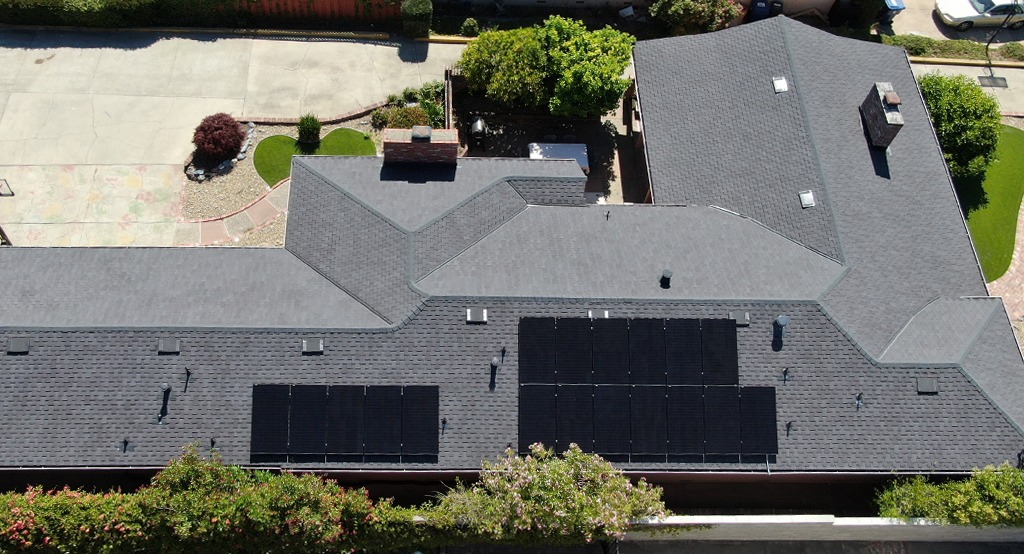10 Years Case Study on PG&E Rate Increases
By Bill Gurgol
My name is Bill Gurgol and I am the owner of the Solar Bill Review Team. We are a small business with less than 20 employees. Last year our whole company revenue was less than 5% of the CEO of PG&E’s personal yearly income in 2021. Yet, somehow, the carousel of 5 CPUC members rationalized it was a good idea to cut our pay and give PG&E yet another bump in revenue. Only 2 of the current 5 CPUC members were decision makers when they originally launched their preliminary decision in December of 2021. Since then, three of the five CPUC commissioners were replaced. In April of this year, a new “Net Billing Tariff” favoring PG&E was implemented. In the meantime, just since the original preliminary decision, PG&E has raised their rates on E1 Residential with an increase of over 20% on Tier 1 and Tier 2. I speak of this rate plan because I recognize this to be the most popular residential rate plan subscribed to over the last 10 years.
Part 1
CPUC Defending Big Utilities with False Information?
Despite mass vexation from most who heard about PG&E’s CEO Patricia Poppe being paid over $50 million in compensation for 2021, she has shown investors why she is worth it. In last year’s report from S&P GLOBAL, she is referred to as the highest paid CEO compensation for investor-owned electric and gas in the US in 2021.
- According to macrotrends, PG&E reported annual revenue of $21.6 billion in 2022.
- In the quarterly report filed with the Securities and Exchange Commission (1), PG&E earned a $623 million profit in Q1 of 2023.
- PG&E’s profits grew by 18.3% comparing 1st quarter of 2022 to 1st quarter of 2023(1).
Solar can create a finish line for all or at least a portion of our electricity expenses. It gives us power when others suggest we should not have power. In search for balance, I am asking a couple questions regarding recent happenings… Is the California Public Utilities Commission simply a carousel of yes people who answer only to the big three multi-billion dollar utility companies? Why do I ask? Please read page 16 of the CPUC Protection Guide. The 4th paragraph under STEP 5 states “Electricity prices and rates can change over time. Electricity bill savings estimates typically assume they will escalate, or rise, by a certain percentage each year (the CPUC has capped the assumed escalation rate at 4 percent for these estimates). This is very clearly a false assumption. Who is this form really protecting? With this article, I am asking for a solution and balance. How about we represent facts on the form that everyone who wants to go solar must sign? Let us give consumers an opportunity to see what is right. Please study the numbers presented. Prior to me signing my 1st client to go solar (me) 10 years ago, I learned and confirmed that PG&E had been raising rates by an average of 6.8% for the previous decades. This was more than double the national inflation average during the same timeframe. $.13 has become $.33 since. Last 10 years average rate increases have been real close to 10% yearly, but according to the CPUC, a solar advisor is not allowed to present the truth in writing to prospective clients? With solar, $.10 will be $.10 in ten years from now or you will be done paying for kilowatt hours because you chose the power of the sun.
I’ve never had any interest in politics, but this is my family’s and my friends’ livelihood. It all comes down to who do you want to give your money to. Unless you are eating nuts and berries and reading books by candlelight for entertainment, someone will continue to use electricity at your home, and we must pay someone. In my next column will share how the new NBT plan affects solar customers.
Part 2
My teammates and I have been reviewing electricity bills, while educating ourselves and others regarding benefits of solar for a little over 10 years now. During my time as a front-line student of SOLAR, I’ve scoured the Internet regarding PG&E rate increases and the only articles I have ever seen are the ones that talk about the rate increase that just happened last week or two months ago. Nothing out there ever showed me a bigger sample size. In 2014, when I first got into SOLAR, I learned in the classroom that PG&E had been raising rates by an average of 6.8% per year over decades. This was confirmed by PG&E employee that I visited with proposing and helping to go SOLAR back in 2015. Yes, PG&E employees, already receiving an employee discount see the value of solar for their own homes as well. We have helped quite a few over the years. Many good people work for PG&E. Since 2014, PG&E rate increases can be confirmed as between 9 to 10% per year average.
Below is a worst-case scenario of someone who saves less than most who have gone solar. We started with $60 electric bill from PG&E. We moved 420 kWh monthly to solar. Back then the most common plan was the no money down and fixed cost, lease. It was no such thing as a solar loan back then. We signed for $.15 a kilowatt hour. The bill became fixed at $63 for year one. Solar agreement states 2.9% yearly escalator. We started off paying three dollars more per month than what it would’ve been to stay with PG&E rate increases. At that time, PG&E’s average yearly rate increases averaged 6.8% as far as we were able to look back. It was a calculated risk.
You started paying more monthly to go solar? What is the good news?
- Since then, PG&E has averaged just under 10% yearly rate increases on Tier 1 and 2 E1 subscribers.
- Anyone who signed for a $63 a month lease agreement with a 2.9% escalator in 2014 is now paying $84.
- Today, that same kWh that PG&E subscribers were paying $.13 and $.15 per kilowatt have almost tripled to $.33 and $.42 per kWh.
- If you are paying PG&E an average bill of $150 today, you were paying less than $60 for 420 kWh with PG&E ten years ago.
- If the most recent 10 years history repeats, then in 10 years from now, a $150 electric bill will become over $350 monthly.

So, does this mean solar was a good investment for someone who signed onto a 20-year lease 10 years ago? Well, if we stayed with PG&E, last year we would have paid $1,800 for electricity instead of $1,000 like we did with solar. This was a net savings of $800 in just one year. If the rate increases continue the way they have, savings will be thousands of dollars per year within the next 10 years. One of the most common concerns people have when they are moving is one of the new people move in don’t want the solar. My answer always is, unless they eat nuts and berries and only read books by candlelight for Entertainment in the evening, it’s most likely whoever buys your house will be using electricity and prefer to pay less rather than more. It’s all about education. A kilowatt hour is a kilowatt hour whether you’re getting it from the power of the sun or from PG&E. SOLAR is ancient and modern at the same time. SOLAR just allows you to pay less. It feels good to be in control of the electric bill. Just ask PG&E.
Part 3
There is No Such Thing as NEM 3
What is the New Net Billing Tariff?
Over the most recent couple of years, a lot was made of the fact that our local utility company, PG&E will be paying less to solar customers who deposit electricity into the grid. If PG&E has lowered the amount of payback on a kilowatt hour sent into the grid, what does this mean to the common working family? Some may say this is indefensible.
Ever hear of the saying “The Best Defense is a Good Offense?”
It has already begun. A California state law is being considered by our newly reconstructed utility friendly California Public Utilities Commission. The NRDC who was also the main promoter of a hoax that led to the “Great Apples Scare” of 1989 has suggested for all PG&E customers who make over $180,000 yearly to pay a minimum of close to $100 minimally monthly. Recently, the Center for Biological Diversity, Environmental Working Group and the Protect Our Communities Foundation filed a lawsuit against the CPUC, PG&E, SCE and SDG&E. The suit alleges that high dollar campaigns launched against energy independence in the last couple years were a “false narrative”. Bill Powers, an energy expert with The Protect Our Communities Foundation suggested “The real problem is heedless pursuit of maximum profit by the utilities at the expense of reasonable rates and common-sense climate action.”
Power of The Sun With Net Billing Tariff
$5 a month is the difference on monthly fixed fees when we go solar with the new Net Billing Tariff. The cost of buying solar energy for Solar homeowners is not affected in any way when the energy that homeowners are able to create with the power of the sun is consumed directly from the sun into our home appliances such as Refrigerator, EV, AC, etc…
Batteries Are The Future
The new Net Billing Tariff does not affect what a rooftop solar customer stores for personal use in a battery. The average family living in a 1,500 square-foot home consumes 3 to 5 kWh while they’re sleeping. A standard Enphase, SolarEdge, SunPower SunVault or Tesla Powerwall battery stores at least 10 kWh. No matter how we look at it, solar and batteries are the future.
What if I Don’t Want a Battery?
For the fastest return on investment, a lower offset will allow greater savings daily. EG: Without battery, offsetting 50-70% of your energy will allow much faster payback period than attempting to get closer to 100%. We are referring to this is as the baby step method. This allows immediate savings. Some solar is better than no solar. Home value is increased if some solar is added. This is an investment into your home and your family’s future rather than paying for last month’s news. A battery can be added at any time later in effort to achieve closest to100% offset.
Any Advantage to Go Solar Sooner?
Anyone who goes solar this year will receive the full value of a kilowatt hour when it’s sent into the grid up until the end of 2023. No battery is necessary to achieve this trade value. The longer people wait to go solar, it has been proven more likely that these giant utility companies change the rules in their own favor. Right now, the big utility companies are in complete control for anyone who does not have solar. The longer families wait, the more likely it is for a less favorable long-term trade value. Net Billing Tariff grandfather period is less than 10 years, but only for customers in the same home where solar was started.
There is NO Middle Ground Here
We all must trust someone. We will either continue giving more and more money to these big utility companies who are still utilizing technology from the late 1800s or invest into the future of our families and our children’s children. Solar can create a finish line for all or at least a portion of our electricity expenses. It all comes down to who do you want to give your money to. Unless you are eating nuts and berries and reading books by candlelight for entertainment, we’re going to continue to use electricity and we must pay someone.

